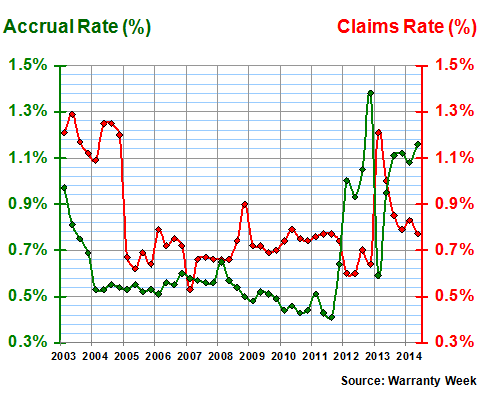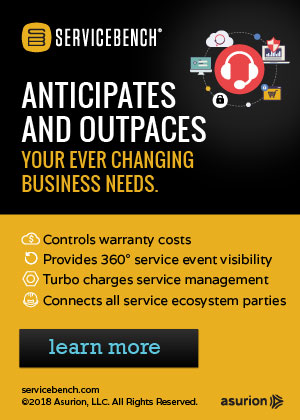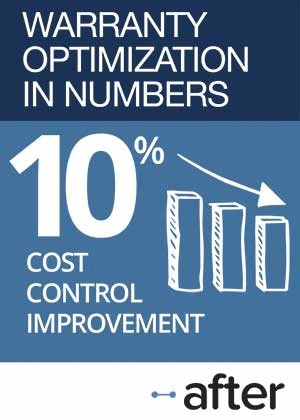Aerospace OEM & Supplier Warranties:Unlike the automotive business, aerospace manufacturers seem to divide warranty expenses equitably between OEMs and suppliers, both as a percentage of their revenue and as a percentage of the total cost.
There is no gap between the aerospace OEMs and their suppliers. Both enjoy relatively low warranty expense rates, which can only be expected in a business where failure is not an option.
However, while a decade ago the two groups might have had comparable warranty expense rates, in the years since they have diverged significantly. The aerospace OEMs have seen their expense rates rise, while the suppliers have seen their expense rates decline.
We currently track 99 U.S.-based companies that have a significant presence in the aerospace industry. Nine of them are OEMs, making airplanes, helicopters, unmanned drones, or commercial satellites. And then 90 are suppliers of systems and parts such as avionics, cabins, seats, cargo equipment, communications and navigation, in-flight entertainment, and engines.
Some of the suppliers sell directly to customers, while others sell to the OEMs, who then incorporate those components into the products they sell to customers. Some of the products get one- or two-year warranties while others have warranties that last a decade or longer. It's a complex set of relationships that can literally fill a three-ring binder full of warranty terms and conditions.
No Gap in Expense Rates
Last week we found a significant gap between the warranty expense rates of the top automotive OEMs and their suppliers. Although the gap has been narrowing, at some points during the past decade the OEMs were paying warranty costs that were two percent higher than their suppliers. If the suppliers paid 0.5% of their revenue in warranty claims costs, the OEMs were paying 2.5%.
We wanted to see if that was also true in the aerospace industry. So we took our list of 99 companies and split it into OEMs and suppliers. However, we made two changes to the supplier group. First, we completely removed General Electric Co. from the list, because most of the company's warranty expenses arise from other industries such as medical equipment and electrical power generation. Also, its warranty expenses are substantial enough to dominate the averages in whichever industry we count them in.
Second, for much the same reason, we placed United Technologies Corp. into its own category. The company is both an aerospace OEM and a supplier, and also generates a significant amount of warranty expense in other industries such as building materials and HVAC. So we can't count them out. But if we count them in, they would dominate the averages in whichever category we put them in.
Therefore, for this week's newsletter, we have three groups. First we have the OEMs, led by Boeing Co., Textron Inc., and General Dynamics Corp. Next we have United Technologies on its own. And third we have the remaining 88 suppliers, led by Honeywell International Inc., L-3 Communications Corp., and Rockwell Collins Inc.
In light of the findings in last week's newsletter about how a handful of automotive OEMs typically pay between 80% and 90% of the industry's total warranty expenses, while their suppliers pay only between 10% and 20% of the total, we set out to see if the same is true in the aerospace industry.
No Gap in Division of Expenses
It most certainly is not. In the aerospace industry, the OEMs typically pay between 30% and 50% of the industry's total claims, and make between 20% to 60% of the industry's accruals. And the reason for that wide range is because the OEMs have seen their warranty expenses rise while their suppliers have seen their costs drop.
Let's begin with an eleven-year look at claims. Back in 2003, the aerospace industry paid out $1.4 billion in warranty claims, and that total was split roughly into thirds. The OEMs paid 35% of the total claims, the 88 suppliers paid 36% of the claims, and United Technologies paid 29% of the claims.
Figure 1
Aerospace Product Warranties
Claims Paid by U.S.-based Companies
(as a percent of the total, 2003-2014)
Over the next seven years, the shares didn't change much. By 2010, the OEM's share was still 34%, but the suppliers were up to 42% and UTC was down to 24%. But then the OEMs' share began to climb, hitting 47% in 2013, while UTC's share continued to fall. During some parts of the years, the OEMs paid almost half the industry total while UTC's share fell under 15%.
So far, in the first half of 2014, the OEMs have paid 46% of the $842 million claims bill, while UTC has paid $168 million or 20%, and the 88 other suppliers have paid $285 million or 34%. That shift can be seen in the widening of the dark blue section in the chart above.
Warranty Accruals
The shift is even more noticeable in terms of warranty accruals. Once again, it starts out divided roughly into thirds. In Figure 2, the aerospace OEMs made about 31% of the accruals in 2003, while UTC made 33% of the total and the other suppliers made 36%.
By 2011, the OEMs' share was up to 33% of the accruals, while UTC's share was down to 28%. The other suppliers contributed the remaining 39% of the $1.7 billion accrual total.
Figure 2
Aerospace Product Warranties
Accruals Made by U.S.-based Companies
(as a percent of the total, 2003-2014)
But then the OEMs' share began to climb dramatically. In 2013 and 2013 their share was 53%. So far in the first half of 2014, their share has been 55%. But in individual quarters, their share has risen to as much as 62%.
Meanwhile, the other 88 suppliers still pay around a third of the total. But UTC's share has dropped considerably, to as low as 10% of the accruals recorded in the second quarter of 2014.
The main reason for this shift is the rising warranty expenses of OEMs such as Boeing and the falling warranty expenses of UTC and other top suppliers. And that shift is happening as both a percentage of the total expenses (Figures 1 & 2) and as a percentage of the total revenue (Figures 3, 4 & 5).
Warranty Expense Rates
In Figure 3, we've taken the total warranty claims and accruals of the OEM group in Figures 1 & 2 and divided each by the reported product revenue of the nine companies. As is plain to see, the data has produced a bathtub-shaped chart over the past 11 years, with relatively high expense rates in 2003 and 2004, low rates from 2005 to 2011, and then high rates again in 2012 to 2014.
Figure 3
U.S.-based Aerospace OEMs
Average Warranty Claims & Accrual Rates
(as a % of product sales, 2003-2014)
Among the suppliers, meanwhile, warranty expense rates continue to drop. In Figure 4 we've tracked the 88 other suppliers and in Figure 5 we've tracked just United Technologies. Even though there's no overlap between them, the two charts have a strikingly similar slope. Their expense rates start out high and end up low.
The suppliers started out in 2003 with a 1.0% claims rate and a 1.1% accrual rate. For the quarter ended in June 2014, their claims rate was 0.62% and their accrual rate was 0.64%. Combine that with the actual dollars involved and the trend is clear: revenue has risen considerably, but warranty expenses have remained about the same, so the expense rates have fallen dramatically over the past decade.
Figure 4
U.S.-based Aerospace Suppliers
Average Warranty Claims & Accrual Rates
(as a % of product sales, 2003-2014)
The same goes for United Technologies specifically. Back in the first half of 2003, the company paid $238 million in claims and made $356 million in accruals, against $10.7 billion in product sales. In the first half of 2014, United Technologies paid $168 million in claims and made $121 million in accruals, against $23.7 billion in product sales.
The results can be seen in Figure 5. The company's warranty expenses rates have fallen from around 2.3% to around 0.6%. Of course, we don't know if that incredible amount of warranty cost-cutting came from elevators or avionics, but we suspect it's part of a company-wide process that impacts Carrier, Sikorsky, Otis, and all the company's lines of business.
Figure 5
United Technologies Corp.
Average Warranty Claims & Accrual Rates
(as a % of product sales, 2003-2014)
On the flip side, while we've seen the warranty expenses climb at several OEMs, none has risen more dramatically than Boeing. Part of the reason must be the trouble the company has had with new product families such as the 787 Dreamliner. But most of those problems are now part of the past.
However, although Boeing claims rate is now returning to a more normal range, its accrual rate, which signals future expectations, has been much higher than normal for nine of the last ten quarters. So is there another problem on the horizon? Or is the company simply being extra cautious?
The Bathtub-Shaped Curve
whatever the reason, in Figure 6 we can see the main reason behind the bathtub shape of Figure 3: it's Boeing. The largest U.S.-based producer of commercial jets is currently at the high end of its range of warranty expense rates, as it also was in 2003 and 2004, but as it hasn't been in the years between.
Figure 6
Boeing Co.
Average Warranty Claims & Accrual Rates
(as a % of product sales, 2003-2014)
There are two ways of looking at this data. The pessimist would note that Boeing's accrual rate has doubled, while the company's claims rate is still above its long-term average. But the optimist would point out that even 1.4% isn't all that high, compared to the warranty expense rates that the passenger car or laptop computer companies are used to seeing.
It's also not an unprecedented warranty expense rate among the major commercial jet manufacturers. Although all of them strive for zero defects and no failures, there are bound to be repair costs from time to time that are paid for under warranty. Boeing has had its problems, especially in the last few years. But so have its competitors.
Embraer's Expense Rates
In Figure 7, we're tracking the warranty expense rates of Embraer S.A., the Brazilian manufacturer of small and medium-sized commercial aircraft. Although the company reports its revenues and expenses in U.S. dollars, we've removed all references to money in favor of just the percentage rates.
Figure 7
Embraer S.A.
Average Warranty Claims & Accrual Rates
(as a % of product sales, 2003-2013)
As is obvious, something went very wrong in 2011. The company's accrual rate, which had never been higher than 3.2%, suddenly spiked to eight percent of revenue. We don't know why accruals spiked so abruptly, and the company's annual report for the year in question provides no clues.
However, no sooner did the company set aside an accrual amount equal to 8.0% of revenue than it made an abrupt reversal equal to 6.7% of revenue. In other words, its net accrual in 2011 was a much more moderate 1.3% of revenue, which is actually a bit below its accrual rate in either 2010 or 2012.
Airbus & EADS Warranty Costs
At Airbus, the warranty expense rates have always remained low. But even they have seen a moderate increase in recent years. Figure 8 tracks the commercial aircraft portion of the European Aeronautic Defence and Space Company, also known as EADS and since earlier this year known as the Airbus Group. It's the parent company of Airbus S.A.S., which accounts for roughly two-thirds of the group's revenue.
Figure 8
EADS N.V. (Airbus Group)
Average Warranty Claims & Accrual Rates
(as a % of product sales, 2003-2013)
As the chart shows, Airbus has managed to keep its claims rate and accrual rate within a tight range of 0.2% to 0.4% of revenue for most of the last 11 years. However, in 2011 its accrual rate climbed to 0.7% and in 2012 it climbed to 0.8%. Strangely, in both those years its claims rate actually dropped below 0.2%.
And then in 2013 the pattern reversed itself. Accruals fell to 0.4% and claims rose to 0.45%. Neither rate is anything to worry about. But it does illustrate how a company that sees a problem coming should raise its accruals before the claims roll in. And then, once the money has been set aside, the accrual rate can return to normal.
Both Airbus and Embraer, by the way, report their warranty expenses only once a year. This is what gives their expense rate charts that staircase-like quality: it's one pair of measurements repeated four times per calendar year. But it also serves to flatten out some of the spikes and dives that would otherwise show up with quarterly measurements.
Not Directly Comparable
Then again, we're not encouraging anyone to compare the expense rates of these three passenger jet OEMs and arrive at any conclusions about product quality or repair cost. Even if all three were using the same currencies and accounting principles, there could be differences in how they account for parts costs, safety recalls, labor rates, and many other factors.
The only way these companies should be compared is to themselves over time. In other words, look at the charts and determine the baseline average. Departures from that baseline -- up or down -- are significant. Differences between the baselines of two different companies are, because of the differences in how they account for the components of cost, going to be different, even if their products are similar.
| 
















